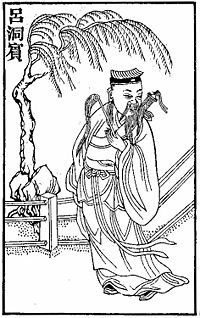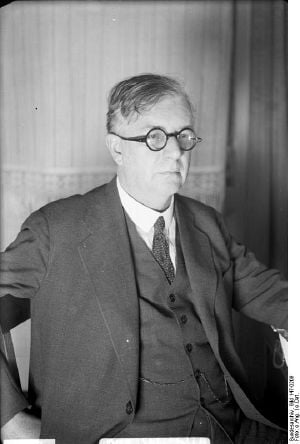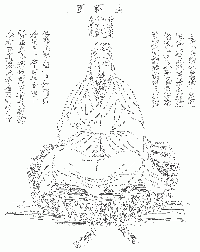The Secret of the Golden Flower
| Part of a series on Taoism | |
Fundamentals | |
Prominent Taoists | |
Deities and Immortals | |
Main Sects | |
Taoist Texts | |
Taoist Precepts | |
Sacred Sites | |
Portal:Taoism | |
The Secret of the Golden Flower ("Tai Yi Jin Hua Zong Zhi",《太乙金華宗旨》), is one of the most important Daoist classics, attributed to the famous Chinese immortal Lü Dongbin (798 C.E. - ?) who is believed to have lived on earth for more than 800 years. Passed on as an oral tradition for centuries, it was written down on wooden tablets during the Song dynasty by a student of Lü Dongbin, Wang Chongyang (1113 – 1170).
It is one of the few Daoist classics that documents the Daoist orthodox “pre-heavenly” approach to cultivating the “golden elixir” (jin-dan, the elixir of life or immortality) that was predominant before the Song dynasty.
Largely ignored by Chinese scholars, it became famous in the West when it was translated into German as "Das Geheimnis der Goldenen Blüte: ein chinesisches Lebensbuch” by Richard Wilhelm (1873 – 1930), a scholar of Chinese classical philosophy.
The book was then translated into English and several other languages, and a new English translation was produced in 1991 by Thomas Cleary.
Contents
“The Secret of the Golden Flower” is an esoteric guide to Daoist meditation techniques, using poetic imagery that informs and confirms the experiences of meditation practitioners according to their own predispositions. The guide describes milestones that mark progress in the course of meditation practice, and the phenomenon that may be observed at each stage of development.
The “golden flower” refers to a bright image, or mandala, that the practitioner will see in front of the mid-point between his or her eyes after developing the practice of meditation. Daoists believe this bright image is closely related to the "Original Essence," "Golden Flower," or "Original Light,” and is a sign that the practitioner is entering the first level of the immortal essence.
Authorship
The authorship of The Secret of the Golden Flower is attributed to the famous Chinese immortal Lü Dong bin (798 C.E. - ?) who is believed to have lived on earth for more than 800 years. According to the translator Richard Wilhelm, Lü was the founder of the School of the Golden Elixir of Life (Jin Dan Jiao), and originator of the material presented in The Secret of the Golden Flower.
Chinese Daoists believe this book was written during the Song dynasty by Lü Dongbin’s student Wang Chong Yang (January 11, 1113 –January 22, 1170) [Chinese calendar: 宋徽宗政和二年十二月廿二 – 金世宗大定十年正月初四] (Traditional Chinese: 王重陽; Simplified Chinese: 王重阳; pinyin: Wáng Chóngyáng), one of the Five Northern Patriarchs of Quanzhen Daoism. According to tradition, in the summer of 1159 he encountered two Taoist immortals, Zhongli Quan and Lü Dongbin, who trained him in esoteric Daoist rituals.
The Secret of the Golden Flower is one of the few Daoist classics, along with the "Tao Teh Ching," "Guan Yinzi" (or "Wenshi Zhenjing"), and the "Jade Emperor Heart Seal Sutra" (Yuhuang Xinyin Jing), that documents the Daoist orthodox “pre-heavenly” approach to cultivating the “golden elixir” (jin-dan), the elixir of life or immortality. This approach, which emphasized the cultivation of “pre-heavenly” or “external” chi acquired from the physical parents at conception, was popular before the Song dynasty. After the Song dynasty, most Daoist schools emphasized the cultivation of “internal” or “post-heavenly” chi, acquired after birth through nourishment, meditation and esoteric practices.[1]
The Secret of the Golden Flower was largely neglected by Chinese scholars because of the relative unpopularity of the “pre-heavenly” approach, and perhaps because Chinese scholars found discrepancies between the theory in this work and other works of Lu Dongbin. It became famous in the West when it was translated into German as "Das Geheimnis der Goldenen Blüte: ein chinesisches Lebensbuch” by Richard Wilhelm, published in 1929. It was translated into English in 1931 as "The Secret of the Golden Flower,” and was later translated into Japanese and other languages.[2] Thomas Cleary, a modern scholar of Eastern studies, produced a new English translation in 1991.
Translations
According to Carl Jung, who wrote an introduction and commentary to "Das Geheimnis der Goldenen Blüte: ein chinesisches Lebensbuch,” Richard Wilhelm (May 10, 1873 - March 2, 1930) was introduced to the work in China by his teacher of Chinese classical philosophy, a sage named Lau Nai Suan [3]. Conveying impressions received from his Chinese teacher, Wilhelm's work portrays the more intuitive aspects of The Secret of the Golden Flower. His translations from Chinese to German were later translated to English by Cary F. Baynes.
Thomas Cleary produced a more rational and scholarly English translation in 1991, and took several opportunities to criticize the validity of Wilhelm's translation. There are significant differences between the Wilhelm and Cleary translations.
The vast differences between ancient Chinese philosophy and modern Western rational thought make it difficult for a novice to grasp the meaning of the book without reading it several times. The poetic lines communicate an imagery that informs and confirms the experiences of meditation practitioners according to their own predispositions. The ideas and perceptions conveyed in the book are better understood with the imagination than with logical reason; in time, with reflection and practice, imagery and reason converge in an informative manner.
Contents
See also
Notes
- ↑ Translation of The Secret of the Golden Flower by Akrishi. Retrieved December 28, 2008.
- ↑ Translation of The Secret of the Golden Flower by Akrishi. Retrieved December 28, 2008.
- ↑ In Carl Jung's autobiography (Memories, Dreams, Reflections, 373-377), he wrote a section about his friend Wilhelm and said, in relevant part, "In China he had the good fortune to meet a sage of the old school whom the revolution had driven out of the interior. This sage, Lau Nai Suan, introduced him to Chinese yoga philosophy and the psychology of the I Ching. To the collaboration of these two men we owe the edition of the I Ching with its excellent commentary." Presumably, the same is true of the yoga philosophy of The Secret of the Golden Flower. Although Wilhelm's original German edition first appeared in the autumn of 1929, just months before he died (according to the Preface by Baynes), Jung indicates in his Foreword to The Secret of the Golden Flower that Wilhelm had sent him the text earlier, and also indicates that it was on Jung's initiative that the book was published.
ReferencesISBN links support NWE through referral fees
- Cleary, Thomas. The Secret of the Golden Flower. HarperOne, 1993. ISBN 0062501933.
- Hook, Diana ffarington. The I Ching and mankind. London: Routledge & Kegan Paul. 1975. ISBN 9780710080585.
- Jung, C.G., Aniela Jaffe, Ed., Clara and Richard Winston, Translators. Memories, Dreams, Reflections. New York: Vintage, 1989. ISBN 0679723951.
- Jung, C. G. Psyche and symbol; a selection from the writings of C.G. Jung. Garden City, NY: Doubleday. 1958. ISBN 9780385093491.
- Lü, Dongbin, and Thomas F. Cleary. The Secret of the golden flower: the classic Chinese book of life. [San Francisco, Calif.]: HarperSanFrancisco. 1991. ISBN 9780062501844.
- Wilhelm, Richard, C. G. Jung, and Hug-yang Liu. The Secret of the golden flower, a Chinese book of life. New York: Harcourt, Brace, & World. 1962. ISBN 9780156799805.
External links
All links retrieved January 24, 2020.
Credits
New World Encyclopedia writers and editors rewrote and completed the Wikipedia article in accordance with New World Encyclopedia standards. This article abides by terms of the Creative Commons CC-by-sa 3.0 License (CC-by-sa), which may be used and disseminated with proper attribution. Credit is due under the terms of this license that can reference both the New World Encyclopedia contributors and the selfless volunteer contributors of the Wikimedia Foundation. To cite this article click here for a list of acceptable citing formats.The history of earlier contributions by wikipedians is accessible to researchers here:
- The_Secret_of_the_Golden_Flower history
- Lü_Dongbin history
- Richard_Wilhelm history
- Wang_Chongyang history
The history of this article since it was imported to New World Encyclopedia:
Note: Some restrictions may apply to use of individual images which are separately licensed.




